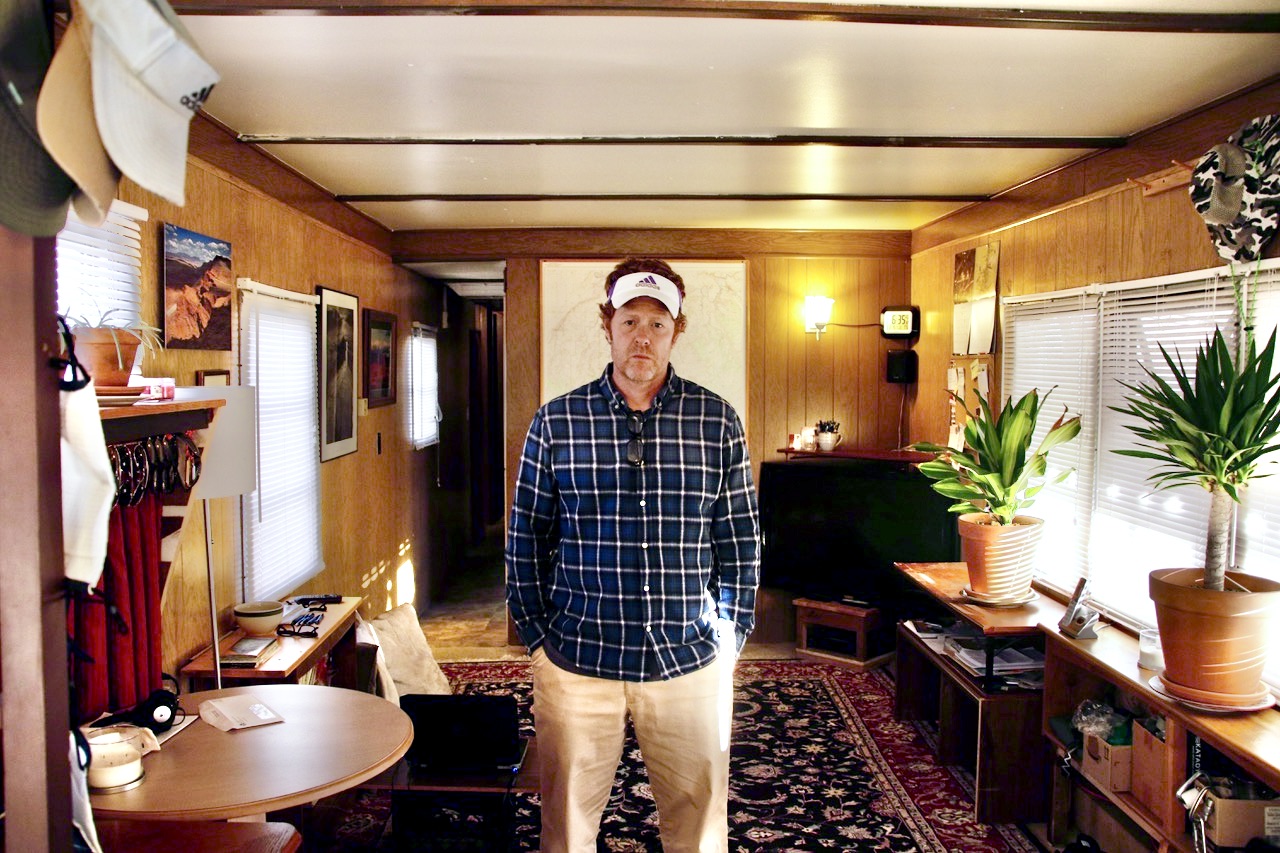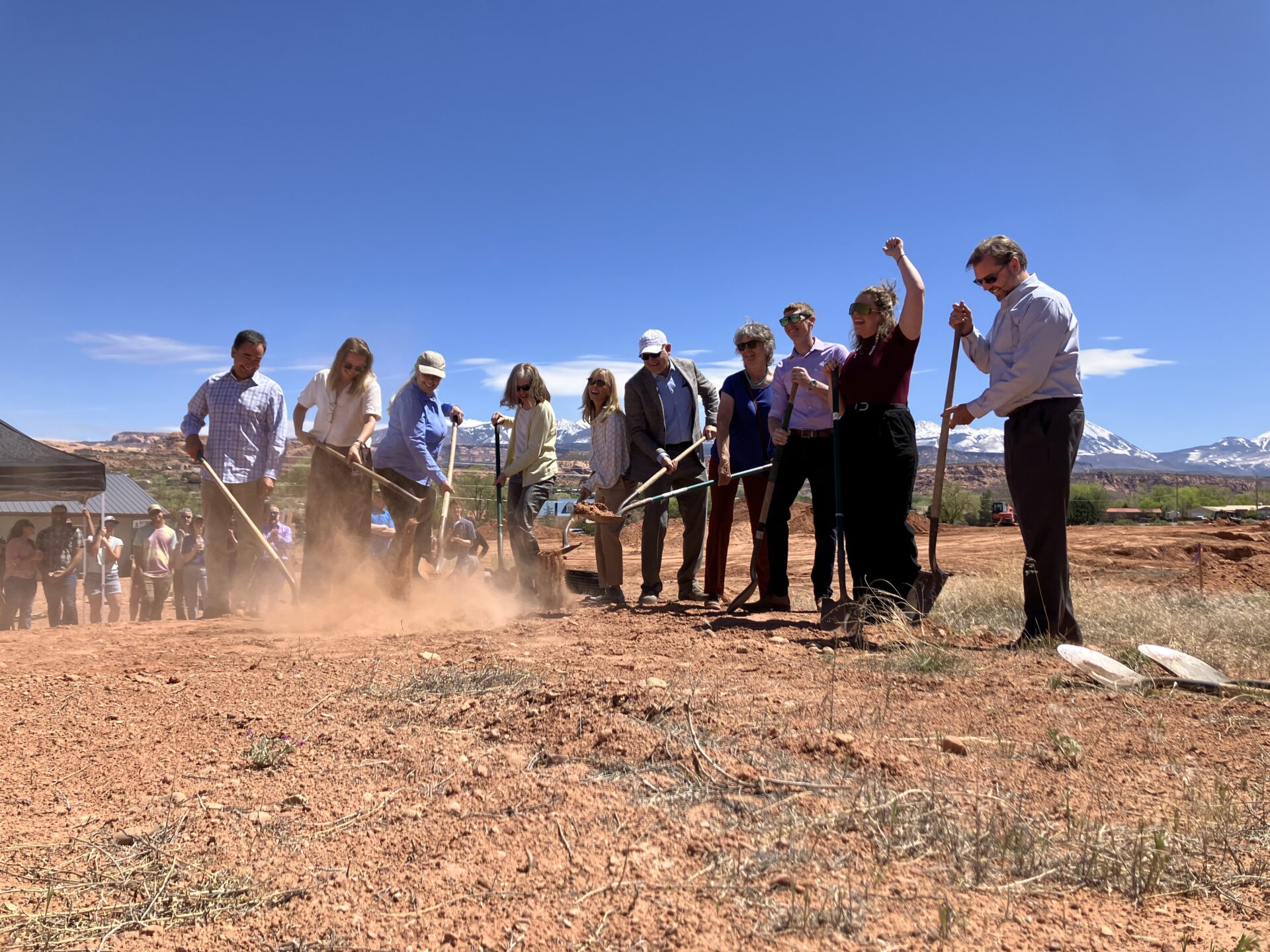Another Moab trailer park is likely to be redeveloped within the next year.
Provo-based development company 2nd Story Capital received unanimous approval from the Moab City Planning Commission to move ahead with plans for an 80-unit complex called Lost Springs Apartments on a 2.24-acre property at 238 S. 400 E.
Twenty mobile homes sit on the property now, 15 of which are occupied.
Planning commissioners welcomed the prospect of more housing in the city, but worried about the current tenants who will be displaced by the project.
Lost Springs Apartments
“We’re excited to hopefully solve some of the desperately needed housing in Moab,” said Josh Godfrey, a representative of 2nd Story Capital, at the Mar. 10 meeting where planning commissioners approved the application. “We bought this property back in 2016 with plans to do some sort of redevelopment.”
The proposed complex would be three buildings, with the tallest at two stories, and have 80 units, as well as a clubhouse and a pool or hot tub. Godfrey also described both covered and open parking, indoor and outdoor bike storage, and a bike repair station. The apartments will not be allowed to be used as short-term rentals—Godfrey said the company envisions them to be fully occupied by year-round residents.
The property is split between two zones: Residential 3 and Commercial 5. Multifamily housing is a permitted use in both of those zones, meaning that provided the developer adheres to building standards, the planning commission does not have discretion in approving or denying the application—their role is simply to ensure the project meets city code.
The R3 part of the project will be subject to a workforce housing ordinance being developed by the city right now, as long as the city finalizes the ordinance by April 10. If that deadline passes and there’s no final draft approved, pending projects will be released from that obligation. Only 12 of the 80 units will be subject to the workforce housing ordinance, under which a yet-to-be-determined percentage of the units must be deed-restricted to “active employment households,” meaning occupants live and work in Grand County.
Planning commissioners acknowledged the balancing act of identifying the optimum percentage of deed-restricted units: Ideally, it won’t be so high that it discourages developers from building in Moab, but to be effective, it must be rigorous enough to produce a substantial number of affordable units. City Planning Administrator Cory Shurtleff said the city council hopes to have the ordinance finalized and passed by the end of March.
Losing housing to gain housing
“We 100% need higher density housing and apartments that locals can afford to rent, own, what have you,” Kya Marienfeld, chair of the planning commission, said. “It’s a bummer that that means displacing existing low income housing.”
Affordable housing is scarce in Moab: the loss of affordable units may force some Moab residents and workers to move elsewhere. Two other residential areas have recently been emptied to make way for development in the past several months: Tenants along Kane Creek Boulevard were asked to leave that property late last fall, and residents of a trailer park on 200 N. were evicted in January.
“We just had a displacement of nine trailers several months ago and we still have people who are homeless in our community,” said Luke Wojciechowski, city councilmember and liaison to the planning commission, at the Mar. 10 meeting. Wojciechowski also serves on the Local Homelessness Coordinating Committee.
Liz Donkersloot is the housing program manager for the Moab Valley Multicultural Center, a local nonprofit that offers a variety of social and community services. She’s worked first-hand with low-income residents trying to find housing. In the online chat during the streamed meeting, she seconded Wojciechowski’s concerns.
“It is so extremely difficult to rehouse individuals in this town, many individuals have to leave town because of a lack of options, creating a big hit to the community workforce,” Donkersloot said.
Residents surprised
Marienfeld also voiced concerns expressed by at least one tenant who was dismayed to find out about the project from public meetings, rather than direct communication from the property owner.
Ian Jewell has lived in Moab for 17 years; for the last 7, he’s lived in a mobile home at the 238 S. 400 E. property. He was caught off-guard when he learned of the planned apartment complex from a friend who happened to be watching a public meeting where it was mentioned. Jewell worried that plans were moving ahead without the knowledge of the people who would be affected first and most—tenants like himself who would be displaced by new development.
Jewell contacted planning commissioners ahead of the Mar. 10 meeting and let the other residents know that they might want to tune in to find out as much as they could about if, and when, they might have to leave.
Marienfeld addressed the lack of communication with tenants at the Mar. 10 meeting.
“The residents there now don’t feel like they were notified and they had to hear this through the grapevine through the planning process of this site plan,” she told Godfrey.
Godfrey assured the planning commission that the needs of the current residents were “top of mind” for the development company—residents had not been notified yet, he said, because the project is still not a certainty. Getting approval to move forward from the city was one step the company wanted to clear before alerting tenants. Even then, Godfrey said, the project may not happen.
“There’s a chance that this gets approved and we can’t make it pencil—construction costs are too much or we can’t get financing,” Godfrey said. “There’s a variety of things that could happen where it could potentially not move forward.”
In a phone call with the Moab Sun News, Godfrey said that if the project doesn’t move forward, the company may continue operating the trailer park as it is—or it may consider offers from other entities to buy the property.
Now that tenants have been alerted, though, Godfrey said the company will issue a formal update this week with information about potential plans. The update is not an eviction notice.
Another tenant, who did not wish to be named, said she was surprised to learn of the intended development, and scared because the only rental options available in Moab right now are very expensive. She lives in one of the trailers with her family of five—they don’t want to leave Moab and take the kids out of the schools they’ve been attending. She said there are around 10 families in the trailer park, and she hopes the property owners will give at least two or three months of notice before they’re asked to leave, so they can make plans to save up for a deposit somewhere else if needed, or put belongings in storage.
The earliest the company could hope to break ground on the new buildings, if all goes smoothly, Godfrey said, would be late summer of this year.
The company has not determined any specifics of how it might assist existing tenants with relocating, but said they will look at offering the right of first refusal of the new units, once they’re ready, to the current tenants. Godfrey said he wasn’t able to give an estimate of what the rental costs will be for those new units, because the cost of construction is still unknown.
The company may also consider phasing construction and allowing at least some residents to stay while the apartments are being built.
“We want to be very considerate and careful how we do this, because we know these people’s lives have been built at this park,” Godfrey said. “Some people have been there for years.”
Long-term rental apartments have long been identified as a need in Moab, and commissioners are hopeful about the project, in spite of the difficulty the current tenants will likely face.
“I am so delighted to see this kind of development before us,” Planning Commissioner Becky Wells said. She asked Shurtleff if city staff or the council were working on options for transitional housing to ease displacements like the one at hand.
Shurtleff told the Moab Sun News that the city is considering creating zoning uses that would open up options for private property owners to offer some kind of alternative housing solution.
Wojciechowski also acknowledged that Moab needs apartments, but also emphasized that the housing stability of fundamental community members is at risk.
“It really is this bittersweet thing that we’re getting these things we’ve been dreaming of at the expense of, once again, the people in our community who are the most vulnerable and least situated to take this big of a shock to the system,” he said. “At the end of the day you guys have a legal right to do what you like with the property that you own, but… there’s a lot of ripple effects that can potentially result from this, even with good intent carried throughout the process.”
Follow up, March 25:
Tenants at a Moab mobile home park were surprised to hear at a public planning commission meeting that the owners of the property where they live have plans to redevelop it into an apartment complex later this year. Housing insecurity is a pressing problem in Moab, and tenants and housing advocates worry about where the displaced renters will go.
After the meeting put some tenants on alert, property owners Hampton Roads, LLC, addressed their renters directly. In a letter dated March 16, Hampton Roads informed tenants that construction on the new multi-family housing project is anticipated to begin in the fall.
“To prepare for development, it is requested that each tenant be completely moved out of their current rental unit before that time,” the letter says. “To help with this transition, a $400 move-out credit + full security deposit will be provided to those who move out by June 30th.”
Hampton Roads is also offering all previous tenants one month of free rent at the new development once it’s ready.
“We expect this project to aid in the current housing shortage in Southeastern Utah and relieve some economic pressures associated with it,” the letter says.
“It really is this bittersweet thing that we’re getting these things we’ve been dreaming of at the expense of, once again, the people in our community who are the most vulnerable.” Luke Wojciechowski




